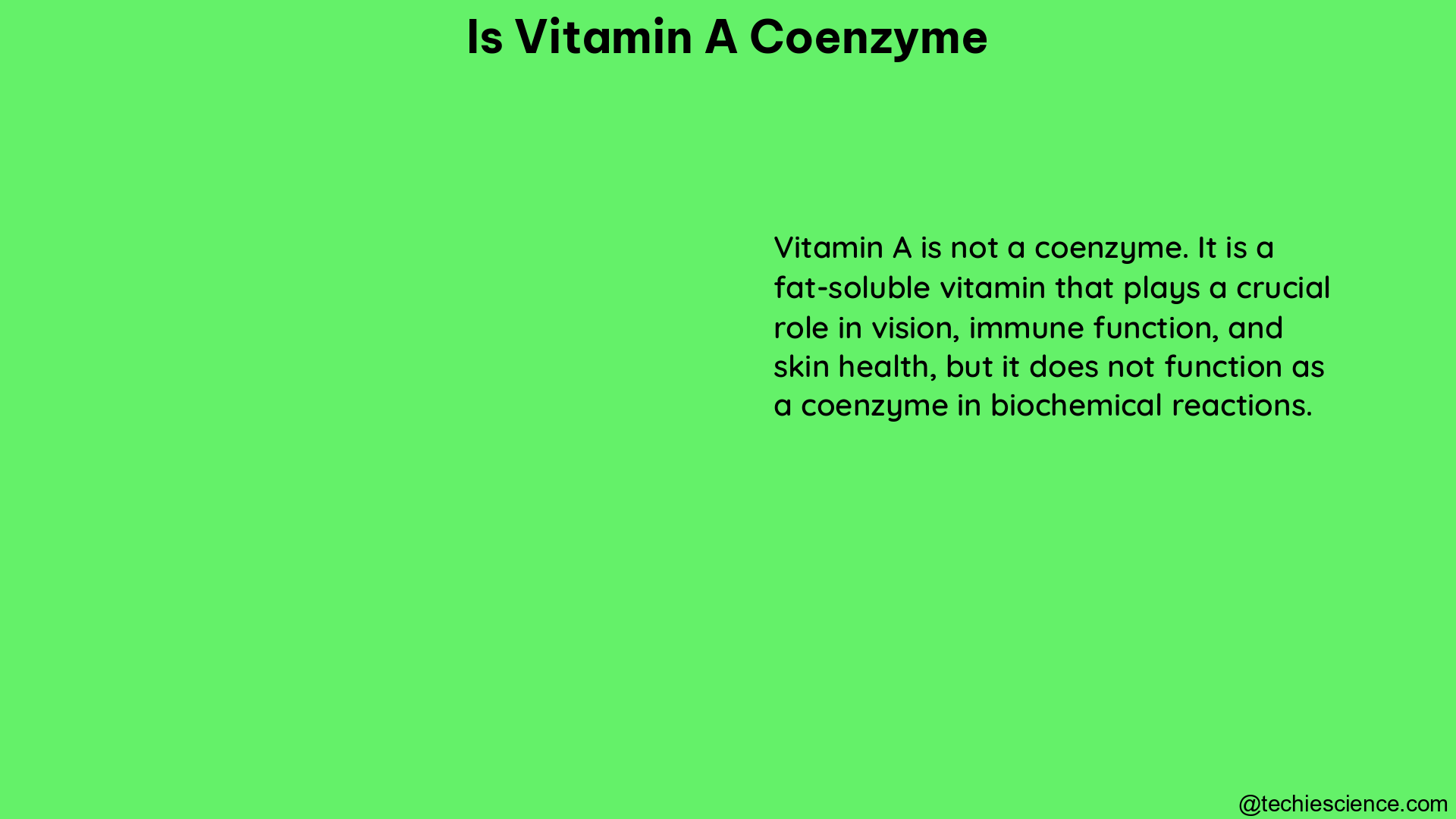Vitamin A is an essential nutrient that plays a crucial role in various physiological processes in the human body. While it is not a coenzyme in the strict sense, it can act as a cofactor for certain enzymes, particularly in the visual system. In this comprehensive blog post, we will delve into the intricacies of vitamin A’s relationship with coenzymes and explore its multifaceted functions within the human body.
Understanding Coenzymes and Vitamin A
Coenzymes are organic molecules that work in conjunction with enzymes to facilitate specific chemical reactions. They are essential for the proper functioning of many enzymes, as they help to increase the rate and efficiency of these reactions. Vitamins, such as vitamin C, vitamin B6, and vitamin B12, can serve as coenzymes in the body.
Vitamin A, on the other hand, is a fat-soluble vitamin that exists in various forms, including retinol, retinal, and retinoic acid. While vitamin A is not a coenzyme in the same way as other vitamins, it can play a role in enzyme function, particularly in the visual system.
Vitamin A and Rhodopsin: The Visual Pigment

One of the primary ways in which vitamin A acts as a cofactor is in the formation of rhodopsin, the visual pigment found in the rods of the eye. Rhodopsin is responsible for facilitating vision in low-light conditions, and it is composed of two main components: the protein opsin and the chromophore, which is a light-absorbing molecule.
The chromophore in rhodopsin is a form of vitamin A called retinal. Retinal is derived from the alcohol form of vitamin A, known as retinol, through a series of enzymatic reactions. The enzyme retinaldehyde reductase catalyzes the conversion of retinol to retinal, which is then incorporated into the rhodopsin molecule.
Without adequate levels of vitamin A, the production of retinal and, consequently, the formation of rhodopsin would be impaired, leading to impaired vision, particularly in low-light conditions. This is why vitamin A deficiency is a leading cause of night blindness, a condition characterized by difficulty seeing in the dark.
Vitamin A and Enzyme Function
While vitamin A is not a coenzyme in the strict sense, it can play a role in the function of certain enzymes. For example, retinoic acid, a metabolite of vitamin A, can act as a ligand for nuclear receptors, which are transcription factors that regulate gene expression.
These nuclear receptors, such as the retinoic acid receptor (RAR) and the retinoid X receptor (RXR), can then interact with specific DNA sequences, known as response elements, to modulate the expression of genes involved in various physiological processes, including cell growth, differentiation, and immune function.
By regulating gene expression, vitamin A can indirectly influence the activity of enzymes involved in these processes. However, it is important to note that vitamin A’s role in enzyme function is more indirect and complex than the direct cofactor function of other vitamins.
Quantifying Vitamin A as a Coenzyme
As mentioned earlier, there are no specific quantifiable data on vitamin A as a coenzyme, as its primary role in the body is as a retinoid rather than a coenzyme. The conversion of retinol to retinal, which is a component of rhodopsin, is the closest vitamin A comes to functioning as a coenzyme.
However, the relationship between vitamin A and rhodopsin is more akin to a cofactor or a prosthetic group, rather than a true coenzyme. Cofactors and prosthetic groups are non-protein components that are tightly bound to an enzyme and are essential for its catalytic activity, but they are not regenerated during the reaction.
In contrast, coenzymes are organic molecules that are transiently bound to an enzyme and are regenerated during the catalytic process. This distinction is important in understanding the role of vitamin A in enzyme function, as it is not a coenzyme in the same way that other vitamins, such as vitamin C or vitamin B6, function as coenzymes.
Vitamin A’s Multifaceted Roles
While vitamin A may not be a coenzyme in the strict sense, it plays a crucial role in various physiological processes beyond its involvement in the visual system. Some of the key functions of vitamin A include:
-
Gene Regulation: As mentioned earlier, retinoic acid, a metabolite of vitamin A, can act as a ligand for nuclear receptors, which regulate gene expression. This allows vitamin A to influence a wide range of cellular processes, including cell growth, differentiation, and immune function.
-
Immune Function: Vitamin A is essential for the proper functioning of the immune system. It helps to maintain the integrity of epithelial barriers, supports the development and function of immune cells, and plays a role in the inflammatory response.
-
Skin Health: Vitamin A is important for the maintenance of healthy skin. It is involved in the regulation of cell growth and differentiation, as well as the production of sebum, which helps to keep the skin moisturized.
-
Reproduction: Vitamin A is crucial for the proper development and function of the reproductive system. It is involved in the production of sperm, the development of the fetus, and the maintenance of healthy placental function.
-
Bone Health: Vitamin A plays a role in the regulation of bone metabolism, influencing both bone formation and resorption. However, it is important to note that excessive intake of vitamin A can have negative effects on bone health.
These diverse functions of vitamin A highlight its importance in maintaining overall health and well-being, even though it is not a coenzyme in the strict sense.
Conclusion
In summary, while vitamin A is not a coenzyme in the same way that other vitamins function as coenzymes, it can play a role in enzyme function, particularly in the visual system. Vitamin A’s primary role in the body is as a retinoid, a class of compounds that includes retinol, retinal, and retinoic acid, which are involved in a wide range of physiological processes.
Understanding the nuances of vitamin A’s relationship with enzymes and its multifaceted roles in the body is crucial for maintaining optimal health and preventing deficiencies or toxicities. By incorporating this knowledge into our understanding of nutrition and physiology, we can better support the overall well-being of individuals and promote a deeper appreciation for the complexities of the human body.
References:
- Alejandro, G. (2021). Vitamin A Update: Forms, Sources, Kinetics, Detection, Function, Deficiency, Therapeutic Use and Toxicity. Nutrients, 13(5), 1703. https://doi.org/10.3390/nu13051703
- NASM NUTRITION Flashcards. Quizlet. https://quizlet.com/608426423/nasm-nutrition-flash-cards/
- Coenzyme – an overview | ScienceDirect Topics. ScienceDirect. https://www.sciencedirect.com/topics/immunology-and-microbiology/coenzyme
- Vitamin A and Immune Function. (2019). Nutrients, 11(5), 1026. https://doi.org/10.3390/nu11051026
- Vitamin A and Bone Health: A Systematic Review of Randomized Controlled Trials. (2018). Nutrients, 10(8), 1003. https://doi.org/10.3390/nu10081003

Hi….I am Shravanthi Vikram, I have completed my master’s in Bioinformatics and have 10 years of teaching experience in Biology.
Let’s connect through LinkedIn-